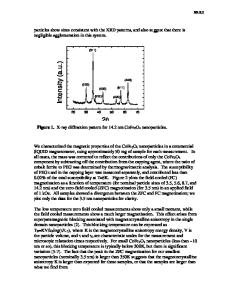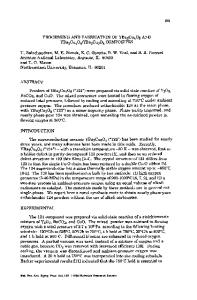Fabrication and Characterization of CoFe 2 O 4 -Polymer Nanocomposite Thin-Films
- PDF / 15,523,192 Bytes
- 6 Pages / 612 x 792 pts (letter) Page_size
- 70 Downloads / 354 Views
Fabrication and Characterization of CoFe2O4-Polymer Nanocomposite Thin-Films Xiaohua Liu1,2,3, Shuangyi Liu1,3, and Stephen O’Brien1,2,3* 1
Department of Chemistry, The City College of New York, New York, NY 10031, U.S.A. Department of Chemistry, The Graduate Center, The City University of New York, New York, NY 10016, U.S.A. 3 Energy Institute, The City University of New York, New York, NY 10016, U.S.A. 2
ABSTRACT Magnetic cobalt ferrite nanoparticles provide a pathway towards nanocomposites, due to the ability to fabricate particle-matrix thin films in the submicron range. In this work flexible particulate 0-3 type thin-films, composed of magnetic CoFe2O4 particles (8-18 nm) and ferroelectric poly(vinylidene fluoride-co-hexafluoropropene) (P(VDF-HFP)) polymer, have been fabricated via multiple spin-coating. The thickness of the thin-films was controlled in the range of 500 nm to 1.2 μm, with magnetic particles dispersively embedded in the polymer matrix. Structural information was analyzed by TEM, XRD, HRTEM and SEM. The dielectric and magnetic properties of the cobalt ferrite/copolymer thin films are systematically investigated. The nanocomposite thin films exhibit composition-dependent effective permittivity and loss tangent, as well as temperature and composition-dependent specific saturation magnetization (Ms). The coercivity (Hc) was not affected by the composite’s composition. These films have great potential in smart magnetic devices and biomagnetic applications. INTRODUCTION Cobalt ferrite (CoFe2O4), from bulk to nano scale, has been extensively studied due to its outstanding magnetic and electrical properties. Distinguished from other transition metal ferrites, cobalt ferrite nanocrystals possess large magnetostriction coefficient and high Curie temperature which enables applications in magnetic recording media, information storage industry, magnetic resonance imaging (MRI) enhancement, sensors, and biomedical applications1,2. Poly(vinylidene fluoride) (PVDF) and its copolymers are well known ferroelectric polymers with their high strength and good stability3. Modifications of PVDF polymers, aiming at improving energy density4, are randomly integrating comonomers such as trifluoroethylene (TrFE), chlorotrifluoroethylene (CTFE), and hexafluoropropylene (HFP)5-8. The introduction of the HFP with bulky –CF3 side groups into the PVDF main chain leads to poly(vinylidene fluoride-co-hexafluoropropene) (P(VDF-HFP)), which have been widely used in polymer electrolyte. Advantages of polymers such as their low densities and mechanical flexibility, made them excellent candidates for composite film fabrication. With various connectivity schemes (e.g. 0-3 particulate type, 2-2 laminate type, and 1-3 fiber/rod type), composite films allow tuning and improving properties from the filler and matrix independently. In the present study we fabricated 0-3 type nanocomposite thin-films composed of CoFe2O4 (CFO) nanoparticles embedded in PVDF-HFP matrix. The nanocrystals are magnetic inverse-spinel type cobalt ferrite nanopa
Data Loading...











